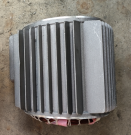


Understanding Pulley Blocks A Comprehensive Overview
Pulley blocks are integral components in the world of mechanical systems, known for their ability to change the direction of force and amplify lifting capabilities. These simple yet effective devices have been utilized for centuries, evolving in design and application to meet the demands of modern engineering. This article delves into the fundamental aspects of pulley blocks, including their types, functions, and practical applications.
A pulley block consists of several key components the wheel, the rope or cable, and the frame. The wheel, or sheave, is designed to facilitate the smooth movement of the rope or cable as it transfers load from one point to another. The frame provides support and stability, while also allowing for easy installation on various structures, from cranes to sailboats.
One of the primary functions of pulley blocks is to change the direction of force
. By rerouting the path of the rope, they allow a user to lift heavy loads with significantly less effort. For instance, if an individual wants to lift an object straight up, pulling down on the rope at an angle can effectively raise the item with greater efficiency. This principle is notably utilized in construction sites and shipping industries, where heavy materials need to be hoisted to significant heights.Pulley blocks come in various types, each suited for specific applications. The most common types include fixed pulleys, movable pulleys, and compound pulleys. A fixed pulley remains stationary while the load moves up and down, primarily serving to redirect force without reducing the effort needed to lift the load. In contrast, movable pulleys are attached to the load, allowing for a mechanical advantage that reduces the effort required to lift it. Compound pulleys combine both fixed and movable pulleys to facilitate even greater efficiency in lifting heavy loads.

The mechanical advantage provided by pulley blocks can be quantified by the number of rope segments supporting the load. For example, a block and tackle system with four rope segments will only require the user to exert a quarter of the load's weight to lift it. This remarkable efficiency is why pulley systems are widely employed in scenarios requiring heavy lifting, such as construction, maritime operations, and rescue missions.
In addition to their lifting capabilities, pulley blocks are also synonymous with versatility. They can be employed in various settings, from industrial environments to recreational activities like sailing. Sailboats utilize pulley blocks to manage sails efficiently, allowing sailors to adjust their rigging with ease, enhancing both performance and safety. In rescue operations, pulley systems play a crucial role in lifting and lowering victims in challenging situations, showcasing their importance in emergency response scenarios.
Despite their simplicity, the effectiveness of pulley blocks cannot be overstated. The engineering principles governing their operation demonstrate the ingenuity behind harnessing mechanical advantage to facilitate various tasks. Understanding the proper application of pulley systems can lead to safer and more efficient practices in diverse fields.
In conclusion, pulley blocks serve as a testimony to the power of simple machines in amplifying human effort and ensuring success in lifting heavy loads. From the construction of skyscrapers to the thrilling world of sailing, their applications are vast and varied. As technology continues to advance, pulley systems may further evolve, yet their fundamental principles will remain integral to the mechanics of lifting and moving loads. Embracing the benefits of pulley blocks is essential for achieving greater efficiency and safety in any lifting operation.



